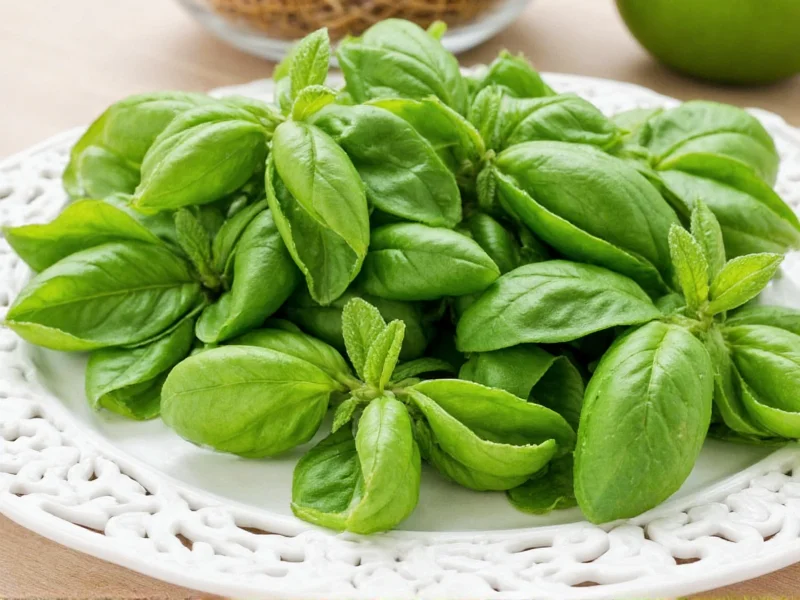Understanding herb conversions is essential for achieving perfect flavor balance in your cooking. When substituting dried basil for fresh (or vice versa), getting the measurements right can make the difference between a dish that sings with herbal notes and one that falls flat.
Why Dried and Fresh Basil Require Different Measurements
The key reason for the 1:3 conversion ratio lies in the dehydration process. Fresh basil contains approximately 90% water, which evaporates during drying. This concentration effect means the essential oils and flavor compounds become more potent in dried form. Professional chefs and food scientists confirm that dried herbs generally deliver three times the flavor intensity of fresh herbs.
When you use dried basil in place of fresh without adjusting measurements, you risk overpowering your dish with herbal notes. Conversely, using equal amounts of fresh basil when a recipe calls for dried will likely result in under-seasoned food that lacks depth.
Complete Dried Basil to Fresh Basil Conversion Chart
| Dried Basil | Fresh Basil Equivalent | Common Recipe Use |
|---|---|---|
| ¼ teaspoon | ¾ teaspoon, chopped | Small batch dressings, single servings |
| ½ teaspoon | 1½ teaspoons, chopped | Sauces for 2 servings, small side dishes |
| 1 teaspoon | 1 tablespoon, chopped | Standard substitution ratio for most recipes |
| 1½ teaspoons | 4½ teaspoons, chopped | Medium-sized pasta sauces, soups |
| 1 tablespoon | 3 tablespoons (¼ cup), chopped | Family-sized recipes, casseroles |
| 2 tablespoons | 6 tablespoons (¼ cup + 2 tbsp), chopped | Large batch cooking, meal prep |
Factors That Affect Basil Conversion Accuracy
While the 1:3 ratio serves as an excellent starting point, several variables can influence the perfect substitution:
Age of Dried Basil
Dried herbs gradually lose potency over time. Basil that's been in your spice cabinet for more than six months may have lost up to 40% of its flavor compounds. For older dried basil, consider using a slightly higher amount—perhaps a 1:2.5 ratio instead of 1:3.
Quality of Fresh Basil
Freshness matters significantly. Basil harvested at peak season from a garden or farmers market contains more essential oils than supermarket basil that's been shipped long distances. When using exceptionally fresh, vibrant basil, you might need slightly less than the standard conversion suggests.
Recipe Type Considerations
The cooking method affects how you should adjust measurements:
- Long-simmered dishes (soups, stews, sauces): Use the standard 1:3 ratio, as dried herbs have time to rehydrate and distribute flavor
- Quick-cooking dishes (stir-fries, omelets): Consider using slightly less dried herb (1:2.75 ratio) since they have less time to mellow
- Raw applications (pesto, salads, garnishes): Always prefer fresh basil when possible, as dried won't provide the same texture or bright flavor
Pro Tips for Perfect Basil Substitutions
Professional chefs recommend these techniques when converting between dried and fresh basil:
- Add dried herbs early: Incorporate dried basil at the beginning of cooking to allow time for rehydration and flavor development
- Add fresh herbs late: Stir fresh basil in during the last 5-10 minutes of cooking to preserve its delicate flavor and vibrant color
- Crush dried herbs: Rub dried basil between your fingers before adding to release more flavor compounds
- Taste and adjust: Always taste your dish before serving and make final seasoning adjustments
- Consider the dish's acidity: In tomato-based dishes, you may need slightly more basil as acidity can mute herbal flavors
Common Conversion Mistakes to Avoid
Even experienced home cooks sometimes make these errors when substituting basil forms:
- Using equal measurements: Treating dried and fresh basil as interchangeable without conversion
- Ignoring recipe timing: Adding fresh basil too early in the cooking process, causing it to lose flavor
- Overcompensating for dried herbs: Using too much dried basil because it doesn't smell as strong when dry
- Not accounting for basil variety: Different basil types (Genovese, Thai, lemon) have varying flavor intensities
- Forgetting about texture: Dried basil won't provide the same visual appeal as fresh in finished dishes
When Fresh Basil Is Truly Irreplaceable
While substitutions work well in many applications, certain dishes absolutely require fresh basil for authentic flavor and presentation:
- Traditional pesto (the texture and color differ significantly with dried)
- Caprese salad (fresh basil provides essential visual and textural elements)
- Garnishes for finished dishes (dried basil won't provide the same visual appeal)
- Raw applications where herbal brightness is crucial
For these specific applications, consider growing your own basil plant—it requires minimal space and provides a continuous supply of fresh leaves. Alternatively, freezing fresh basil in olive oil preserves much more flavor than the drying process.











 浙公网安备
33010002000092号
浙公网安备
33010002000092号 浙B2-20120091-4
浙B2-20120091-4